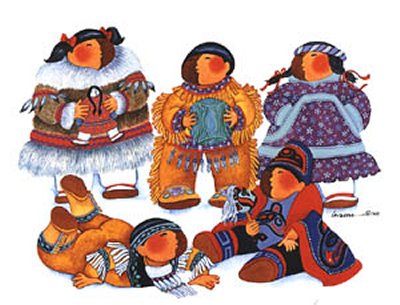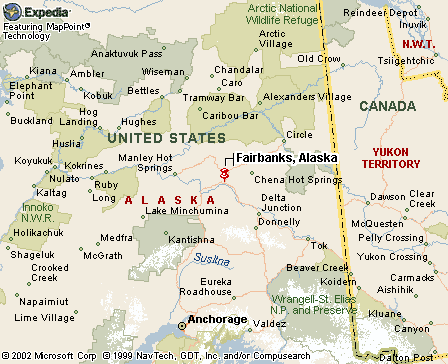|
|
Canku Ota |
|
|
(Many Paths) |
||
|
An Online Newsletter Celebrating Native America |
||
|
June 29, 2002 - Issue 64 |
||
|
|
||
|
Athabascan Language Conference Opens |
||
|
by Mary Beth Smetzer Staff
Writer Fairbanks Daily News Miner
|
||
|
credits: art Children
of the North by Barbara Lavallee
|
|
About a dozen of Isaac's relatives and friends sang with him before almost 150 linguists, Athabascan speakers, educators and policy makers gathered in the UAF Wood Center ballroom. The solemn prayer song gives thanks and asks God's blessings, Isaac explained beforehand. He also told of his reluctance to pick up a drum and lead the singing and dancing as his father and his father's people did. But with the continuing loss of traditional elders in his community over the last decade and more, Isaac realized it was his turn. "In a way it's returning the favors of my father's people to lead the singing and dancing," he said. The new song was particularly apropos since this year's conference theme is "Beyond Revitalization: Toward a sustainable future for Athabascan languages." A large map at the front of the gathering delineated not only the 11 areas in Alaska where 11 different Athabascan languages are spoken, but the black language demarcation lines swoop down, crossing borders through Canada, California and the southwestern United States . The Athabascan language family is large and the tap root for 35-40 offspring such as Tagish, Slave, Dene, Tuchone, Navajo and Apache. Linguist James Kari calls Athabascan the "the prehistoric language of North America." One of the newer Native language immersion programs in California that has been successful is called a master-apprentice program where speakers of the language and younger adult learners who didn't learn the language in their homes work together in teams. Leanne Hinton of University of California Berkeley explained that over the past decade teams have been trained for a weekend to live their lives together, learning the Native language. "They learn through their actions together, pictures and doing things together, like a child learns a language," she said. The language teams dedicate 10 to 20 hours a week together for three years to the learning process. "A lot of teams have been successful and become proficient speakers," Hinton said. In California, where 90 Native languages were once spoken, there are now only 50 languages spoken and none have young children learning the language at home. The other 40 languages have no fluent living speakers, only archived records. Gordon Bussell grew up on a reservation in California but didn't learn the Hoopa language until he was an adult. He was involved in the first Athabascan master-apprentice program and today estimates he is about 50 percent proficient. What Bussell has found especially intriguing is the different cultural perspective of the world one gains by learning a language. "All these views in my culture, your culture, seek them out," he said. Bussell lost one of his traditional teachers this past year. His surviving language mentor is 94. The elders' knowledge of traditional prayers and ceremonies in the old language was passed on to him. Bussell also learned slang. The combination has been enriching, but the toughest hurdle to overcome, Bussell said, was speaking the language in front of others. "I would learn by mimicking . . . so I can learn to say it. That's good for they (teacher) can say this is better.'' Learning a language also means laughing a lot, Bussell said. "You twist your tongue the wrong way and it comes out dirty. "It was the master-apprentice program that got me talking. You are afraid of being laughed at, but they're not laughing at you but with you. You have to go on even if you make mistakes, and you can't quit." At the end of Sunday's session, Dr. Michael Krauss, professor emeritus who founded the Alaska Native Language Center at UAF 30 years ago next month, was honored by his colleagues.
|
|
|
||
|
|
||
| Canku Ota is a free Newsletter celebrating Native America, its traditions and accomplishments . We do not provide subscriber or visitor names to anyone. Some articles presented in Canku Ota may contain copyright material. We have received appropriate permissions for republishing any articles. Material appearing here is distributed without profit or monetary gain to those who have expressed an interest. This is in accordance with Title 17 U.S.C. section 107. | ||
|
Canku Ota is a copyright © 2000, 2001, 2002 of Vicki Lockard and Paul Barry. |
||
 |
 |
|
|
The "Canku Ota - A Newsletter Celebrating Native America" web site and its design is the |
||
|
Copyright © 1999, 2000, 2001, 2002 of Paul C. Barry. |
||
|
All Rights Reserved. |
||
 The
haunting strains of a potlatch prayer song, led in a strong voice by
its composer Jerry Isaac of Tanacross, opened the Athabascan Languages
Conference Sunday afternoon.
The
haunting strains of a potlatch prayer song, led in a strong voice by
its composer Jerry Isaac of Tanacross, opened the Athabascan Languages
Conference Sunday afternoon.